 ...........................................................................................................
...........................................................................................................
Subregion IVa – Thrace
Tell Karanovo
This assessment of the Tell Karanovo radiocarbon evidence is limited to the dates from the new Nikolov/Hiller excavations (carried on the south sector of the site between 1984–1992 and in 1994). Consequently, the three Berlin dates from sector III (Bln-152, Bln-201 and Bln-234) and the one from sector IV (Bln-158), all from the earlier excavations by Georgiev, are omitted from consideration, since their exact connection to the new trenches is unclear. More importantly, omitted are also the two early dates from level I.1 Bln-4339 and Bln-4336, together spanning a range between 6060–5850 cal BC (1σ), which seem outliers to the remaining four dates from the same level, or else are subject to the 'old-wood' effect, potentially being from building posts. Likewise treated as outliers are dates Bln-4177 and Bln-4179, which contradict the sequence. Eighteen dates thus remain for analysis. Fourteen of these are on unidentified charcoals, two of which deriving from ovens, another one collected from a post-hole likely representing a building post (combined samples Bln-3716+Bln-3716H+Bln-3586). All these samples can potentially represent 'old wood', therefore only provide backdrops of termini post quos events. Short-lived seed (mostly lentils (?)) samples stem from the burnt level III only. Although they should theoretically stem from the same destruction event, they still have a BP range of 150 yr. The model generated has good agreement (Amodel:97) (Figure 1).
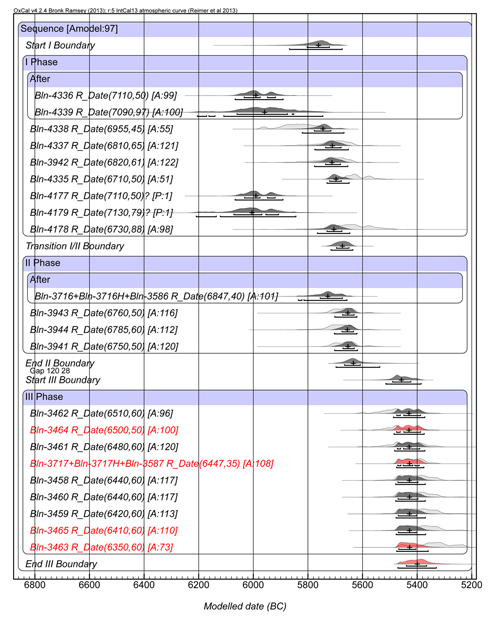
The simplified boundary model (Figure 2) is tabulated in Table 1.
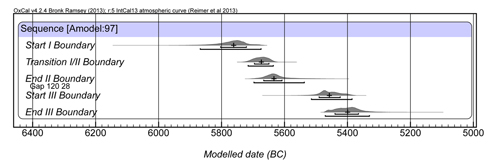
Tell Azmak
The Azmak dates fit well into a sequence model, apart from two very early dates which may suffer from the 'old-wood' effect (Bln-293 and Bln-291). These two are included in the model below as termini post quos. Additionally, given the fact that level I-3 had burned, the charred seed sample date Bln-297 can be treated as a reliable indicator for the end of level I-3. The same argument is valid for seed sample Bln-292 and charcoal sample Bln-294 both from level I-1, that also burnt down. With these constraints in place, the remaining dates show excellent agreement (Amodel:100), even though most samples are on charcoal from slow-growing trees and their dates should be treated as termini post quos. Their relative contextual soundness is, however, corroborated by a total of five dates on seeds and/or grain, which yield similar agreement indices as the charcoal dates (Figure 3).
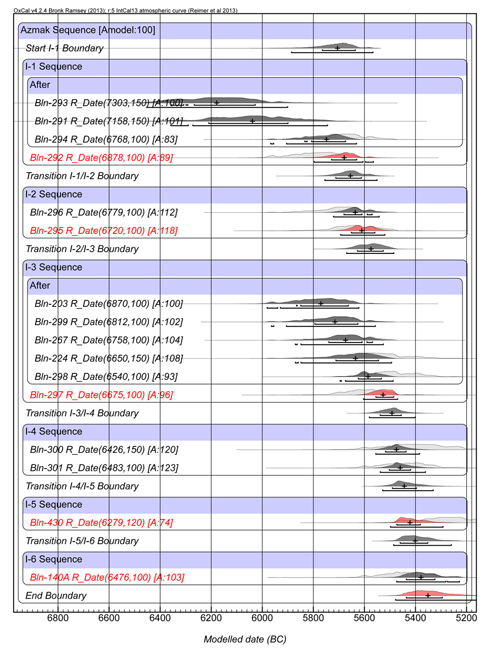
The second half of the Azmak sequence (levels I-4 to I-6) is less tightly dated than levels I-1 to I-3. The dates from levels I-4 and I-5 involve two charcoal samples in I-4 (Bln-300 and Bln-301), and a seed sample (Bln-430) with a rather low agreement (A:69) in I-5. In view of this unbalanced representation of dates (note that also architectural remains from levels I-4 to I-6 are fragmentarily preserved only), a curtailed sequence model may be useful and perhaps more tightly fixing the beginning of the site in time (Figure 4). This model doesn't deviate too much from the above one, the major difference being that the onset of the site would have taken place within a timespan set back a generation earlier (Table 2).
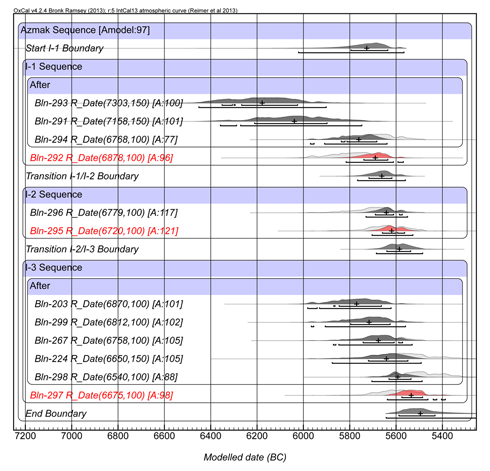
Čavdar
Bln-2662 is taken as the earliest possible date that could correlate with the prevailing final Karanovo I/full Karanovo II phase as visible from the site's material culture. The earlier dates, appearing in two clusters, one situated in the late 7th mill. cal BC, the other between 6000–5800 cal BC, seem too old for the assemblage at hand, and they are considered here as termini post quos (TPQ), their (unidentified) charcoal possibly stemming from 'old wood'. A similar 'old-wood' effect might explain the outlier dates Bln-4261, Bln-1241+Bln-1241A and Bln-908+Bln-998, which contradict the stratigraphic sequence. On the other hand, Bln-2107 appears too young for level VI. The remaining dates, also on unidentified charcoal, and hence also only supplying TPQ events, have the advantage that they fit a stratigraphic order plus that they are in conjunction with the accepted date of what constitutes 'Karanovo II', viz. the 57th C cal BC (see above, Azmak and Karanovo assessments). With these constraints in place, the boundary model has satisfactory overall agreement (Amodel: 75; Figure 5).
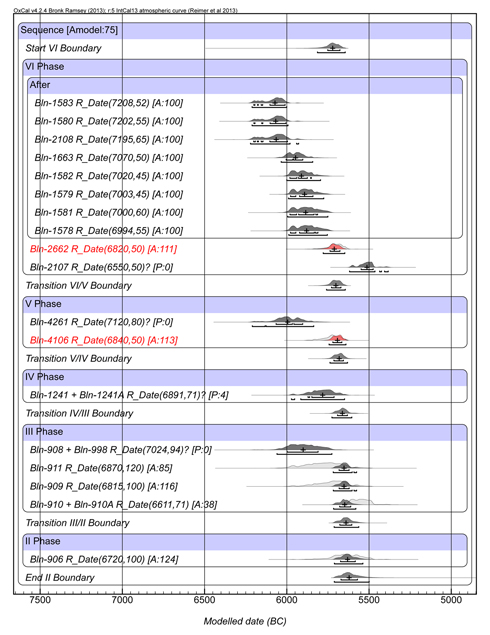
The boundary model as proposed demonstrates that the overall duration of Čavdar is quite short, and limited to a median span of a hundred years, between 5720–5620 cal BC. The calculated durations per level would have a median date of 20 years (Table 3, Figure 6). Applying an 'archaeological wiggle matching' (AWM) approach on the Čavdar data, Weninger tends to favour a 25-year duration per level as the most realistic one (Weninger 1992: 414).
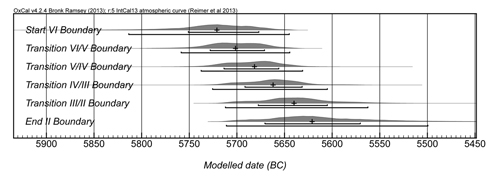
Aşağı Pınar
There is a discrepancy in the date sequence of the site: the four later dates from level 4 (Bln-4999, 4860, 4853 and 4607) and the one date from level 3/4 (Bln-4702), ranging between 5230–4940 and 5010–4850 cal BC (1σ), resp., are younger than the two data from stratigraphically later level 3 (KIA-19258 and KIA-19257) having a total range between 5330–5210 cal BC. Now, Aşağı Pınar 2 has a culturally similar assemblage to nearby site Toptepe level 5 (which has a radiocarbon range between 5300–4950 cal BC over 6 data). While at Aşağı Pınar no dates are available for level 2 strictly speaking, the Toptepe range is filled by the late dates cluster from level 4 and 3/4 as per above. Proposal therefore is to re-tag those dates to AP 2 and 1 instead (Table 4). A series of dates from levels 5, 4/5, and the earlier ones from level 4 have also been slightly re-labelled, but these divisions are in fact arbitrary, since the dates are close-packed, indicating a continuous sequence punctuated by radiocarbon events close to one another.
Despite the presence of four level 6 dates later than the two dates on short-lived plant material from house APA (Bln-5218 and Bln-5219), it is probably these two that determine the end date of the house, which has burnt down. The remaining level 6 dates are treated as termini post quem in the model below. As regards the revised level 3, the samples from unidentified charcoal likewise serve as events post quos for the short-lived sample dates KIA-19258 and 19257 (Figure 7).

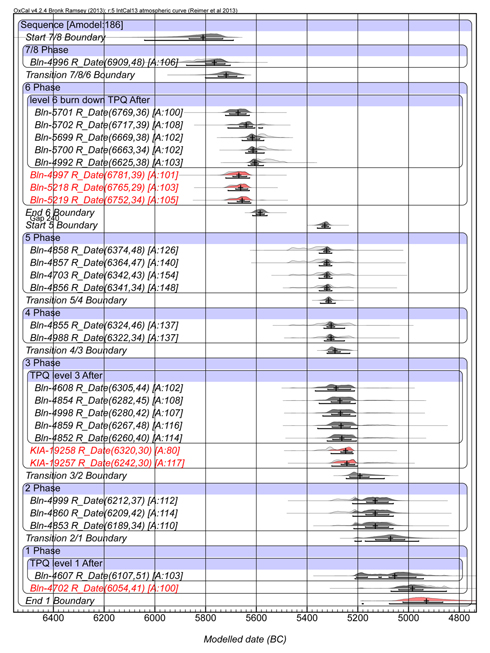
Drama-Gerena
The radiocarbon dates confirm the cultural assignment by Lichardus, modified later by Nikolov (2010:119) where Gerena A and B are Karanovo III–IV (Lichardus: IIIa & IIIb, resp.), and Gerena C is Karanovo IV (Figure 8, Table 5).
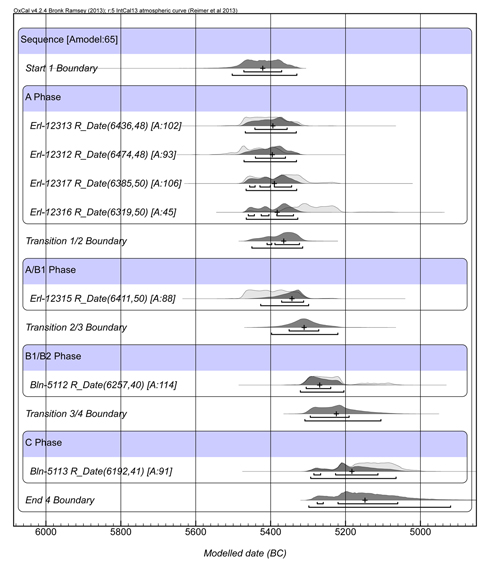
The table below shows that Gerena C conforms well with, e.g., (revised) Aşağı Pınar 2, and with Toptepe level 5.
Toptepe
Seven radiocarbon samples on unidentified charcoal divide between a 'pre-level 5' and a 'level 5' sequence. Level 5 has burnt and yields the famous ceramic anthropomorphic vessel (Figure 9).
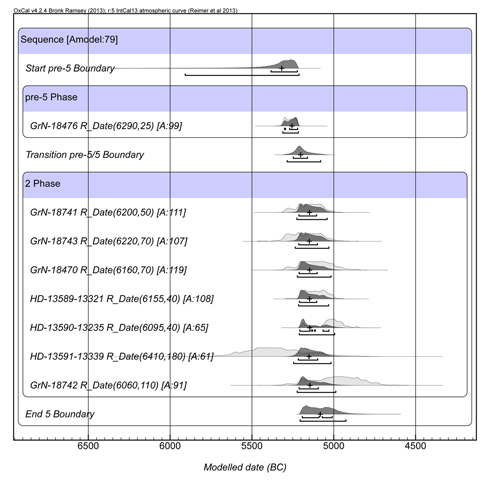
Despite some deviating dates with large StD (Hd-13591-13339 and GrN-18742), level 5 is consistently datable between 5250–5160 (median 5200) for its start, and 5200–5010 (median 5080) cal BC for its end, all at 1σ. These dates confirm the pottery parallels with contemporary Aşağı Pınar 2.
General assessment Eastern Thrace, Neolithic
The radiocarbon evidence above just might suggest that it was only around 5800 cal BC, or during the 58th C, that sites such as Tell Karanovo, Tell Azmak, Čavdar – and possibly Aşağı Pınar as well – were founded (in several cases on a layer of ashes above virgin soil). This first round of villages might be subsumed as 'Karanovo I', lasting throughout the 58th C, followed up without a break by the Karanovo II and Karanovo II–III periods in the 57th and 56th centuries cal BC, resp. Continuity persisted during the 55th C, now generally called 'Karanovo III.'
The Toptepe level 5 date range between medians 5200–5080 cal BC has overlaps with a series of sites in Thrace and South Romania, as follows:
The following sites will be discussed: Tell Karanovo, Tell Azmak, Čavdar, Aşağı Pınar, Drama-Gerena and Toptepe, in order of appearance.
Tell Karanovo
This assessment of the Tell Karanovo radiocarbon evidence is limited to the dates from the new Nikolov/Hiller excavations (carried on the south sector of the site between 1984–1992 and in 1994). Consequently, the three Berlin dates from sector III (Bln-152, Bln-201 and Bln-234) and the one from sector IV (Bln-158), all from the earlier excavations by Georgiev, are omitted from consideration, since their exact connection to the new trenches is unclear. More importantly, omitted are also the two early dates from level I.1 Bln-4339 and Bln-4336, together spanning a range between 6060–5850 cal BC (1σ), which seem outliers to the remaining four dates from the same level, or else are subject to the 'old-wood' effect, potentially being from building posts. Likewise treated as outliers are dates Bln-4177 and Bln-4179, which contradict the sequence. Eighteen dates thus remain for analysis. Fourteen of these are on unidentified charcoals, two of which deriving from ovens, another one collected from a post-hole likely representing a building post (combined samples Bln-3716+Bln-3716H+Bln-3586). All these samples can potentially represent 'old wood', therefore only provide backdrops of termini post quos events. Short-lived seed (mostly lentils (?)) samples stem from the burnt level III only. Although they should theoretically stem from the same destruction event, they still have a BP range of 150 yr. The model generated has good agreement (Amodel:97) (Figure 1).
—L.T.

Fig. 1. Tell Karanovo levels I–III sequence model. Short-lived charred seed samples in red.
The simplified boundary model (Figure 2) is tabulated in Table 1.
| Boundaries | Cal BC range (1σ) | Median |
| Start level I | 5810–5720 | 5760 |
| Transition I/II | 5700–5650 | 5670 |
| End level II | 5670–5600 | 5630 |
| Assumed gap of 120 yr | ||
| Start level III | 5500–5420 | 5460 |
| End level III (burnt) | 5440–5360 | 5400 |
Table 1. Tell Karanovo I–III durations.

Figure 2. Tell Karanovo I–III boundaries.
Tell Azmak
The Azmak dates fit well into a sequence model, apart from two very early dates which may suffer from the 'old-wood' effect (Bln-293 and Bln-291). These two are included in the model below as termini post quos. Additionally, given the fact that level I-3 had burned, the charred seed sample date Bln-297 can be treated as a reliable indicator for the end of level I-3. The same argument is valid for seed sample Bln-292 and charcoal sample Bln-294 both from level I-1, that also burnt down. With these constraints in place, the remaining dates show excellent agreement (Amodel:100), even though most samples are on charcoal from slow-growing trees and their dates should be treated as termini post quos. Their relative contextual soundness is, however, corroborated by a total of five dates on seeds and/or grain, which yield similar agreement indices as the charcoal dates (Figure 3).

Figure 3. Tell Azmak boundary model 1. Samples on short-lived materials in red.
The second half of the Azmak sequence (levels I-4 to I-6) is less tightly dated than levels I-1 to I-3. The dates from levels I-4 and I-5 involve two charcoal samples in I-4 (Bln-300 and Bln-301), and a seed sample (Bln-430) with a rather low agreement (A:69) in I-5. In view of this unbalanced representation of dates (note that also architectural remains from levels I-4 to I-6 are fragmentarily preserved only), a curtailed sequence model may be useful and perhaps more tightly fixing the beginning of the site in time (Figure 4). This model doesn't deviate too much from the above one, the major difference being that the onset of the site would have taken place within a timespan set back a generation earlier (Table 2).

Figure 4. Tell Azmak boundary model 2 - for the first three levels I-1 – I-3. Red indicates short-lived samples.
| Model 1 | Model 2 | |||
| Phase boundary | Cal BC (1σ range) | Median | Cal BC (1σ range) | Median |
| Start level I-1 | 5770–5630 | 5710 | 5800–5630 | 5730 |
| I-1/I-2 | 5720–5610 | 5650 | 5720–5610 | 5660 |
| I-2/I-3 | 5630–5520 | 5570 | 5650–5530 | 5590 |
| I-3/I-4 | 5540–5450 | 5490 | 5590–5430 | 5500 |
| I-4/I-5 | 5500–5400 | 5450 | ||
| I-5/I-6 | 5470–5350 | 5400 | ||
| End I-6 | 5440–5290 | 5360 | ||
Table 2. Tell Azmak alternative level durations.
Čavdar
Bln-2662 is taken as the earliest possible date that could correlate with the prevailing final Karanovo I/full Karanovo II phase as visible from the site's material culture. The earlier dates, appearing in two clusters, one situated in the late 7th mill. cal BC, the other between 6000–5800 cal BC, seem too old for the assemblage at hand, and they are considered here as termini post quos (TPQ), their (unidentified) charcoal possibly stemming from 'old wood'. A similar 'old-wood' effect might explain the outlier dates Bln-4261, Bln-1241+Bln-1241A and Bln-908+Bln-998, which contradict the stratigraphic sequence. On the other hand, Bln-2107 appears too young for level VI. The remaining dates, also on unidentified charcoal, and hence also only supplying TPQ events, have the advantage that they fit a stratigraphic order plus that they are in conjunction with the accepted date of what constitutes 'Karanovo II', viz. the 57th C cal BC (see above, Azmak and Karanovo assessments). With these constraints in place, the boundary model has satisfactory overall agreement (Amodel: 75; Figure 5).

Figure 5. Čavdar boundary model Levels VI–II. In red the dates from Levels VI and V that set the pace for the chronological devolvement seen from the assumption of Čavdar basically being a Karanovo II site. Except for Bln-910+Bln-910A with a low Agreement index of 38, the remaining Levels III and II dates show good agreement within the overall model.
The boundary model as proposed demonstrates that the overall duration of Čavdar is quite short, and limited to a median span of a hundred years, between 5720–5620 cal BC. The calculated durations per level would have a median date of 20 years (Table 3, Figure 6). Applying an 'archaeological wiggle matching' (AWM) approach on the Čavdar data, Weninger tends to favour a 25-year duration per level as the most realistic one (Weninger 1992: 414).
—L.T.
| Phase boundary | Cal BC (1σ range) | Median |
| Start VI | 5760–5670 | 5720 |
| Trans. VI/V | 5730–5670 | 5700 |
| V/IV | 5720–5650 | 5680 |
| IV/III | 5700–5630 | 5660 |
| III/II | 5680–5600 | 5640 |
| End II | 5680–5570 | 5620 |
Table 3. Čavdar durations and median dates for start, transitions and end. Note that the excavators mention an (unpublished, undated) level VII. A much perturbed level I remains undated as well.

Figure 6. Čavdar durations overall and per level.
Aşağı Pınar
There is a discrepancy in the date sequence of the site: the four later dates from level 4 (Bln-4999, 4860, 4853 and 4607) and the one date from level 3/4 (Bln-4702), ranging between 5230–4940 and 5010–4850 cal BC (1σ), resp., are younger than the two data from stratigraphically later level 3 (KIA-19258 and KIA-19257) having a total range between 5330–5210 cal BC. Now, Aşağı Pınar 2 has a culturally similar assemblage to nearby site Toptepe level 5 (which has a radiocarbon range between 5300–4950 cal BC over 6 data). While at Aşağı Pınar no dates are available for level 2 strictly speaking, the Toptepe range is filled by the late dates cluster from level 4 and 3/4 as per above. Proposal therefore is to re-tag those dates to AP 2 and 1 instead (Table 4). A series of dates from levels 5, 4/5, and the earlier ones from level 4 have also been slightly re-labelled, but these divisions are in fact arbitrary, since the dates are close-packed, indicating a continuous sequence punctuated by radiocarbon events close to one another.
Despite the presence of four level 6 dates later than the two dates on short-lived plant material from house APA (Bln-5218 and Bln-5219), it is probably these two that determine the end date of the house, which has burnt down. The remaining level 6 dates are treated as termini post quem in the model below. As regards the revised level 3, the samples from unidentified charcoal likewise serve as events post quos for the short-lived sample dates KIA-19258 and 19257 (Figure 7).
—L.T.

Table 4. AP alternative level proposal based on the radiocarbon evidence (omitted here are those dates with no reported provenance (see Excel file for full data)).

Figure 7. Aşağı Pınar sequence model based on the alternative phasing (Table 4), with short-lived samples in red, and an assumed gap of 240 yr between levels 6 and 5.
Drama-Gerena
The radiocarbon dates confirm the cultural assignment by Lichardus, modified later by Nikolov (2010:119) where Gerena A and B are Karanovo III–IV (Lichardus: IIIa & IIIb, resp.), and Gerena C is Karanovo IV (Figure 8, Table 5).

Figure 8. Drama-Gerena sequence model.
The table below shows that Gerena C conforms well with, e.g., (revised) Aşağı Pınar 2, and with Toptepe level 5.
—L.T.
| Boundaries | Cal BC (1σ) range | Median |
| Start A | 5480–5370 | 5420 |
| Transition A / B1 | 5410–5320 | 5370 |
| Transition B1 / B2 | 5360–5270 | 5310 |
| Transition B2 / C | 5300–5190 | 5230 |
| End C | 5280–5060 | 5150 |
Table 5. Drama-Gerena boundary model.
Toptepe
Seven radiocarbon samples on unidentified charcoal divide between a 'pre-level 5' and a 'level 5' sequence. Level 5 has burnt and yields the famous ceramic anthropomorphic vessel (Figure 9).

Figure 9. Toptepe sequence model.
Despite some deviating dates with large StD (Hd-13591-13339 and GrN-18742), level 5 is consistently datable between 5250–5160 (median 5200) for its start, and 5200–5010 (median 5080) cal BC for its end, all at 1σ. These dates confirm the pottery parallels with contemporary Aşağı Pınar 2.
—L.T.
General assessment Eastern Thrace, Neolithic
The radiocarbon evidence above just might suggest that it was only around 5800 cal BC, or during the 58th C, that sites such as Tell Karanovo, Tell Azmak, Čavdar – and possibly Aşağı Pınar as well – were founded (in several cases on a layer of ashes above virgin soil). This first round of villages might be subsumed as 'Karanovo I', lasting throughout the 58th C, followed up without a break by the Karanovo II and Karanovo II–III periods in the 57th and 56th centuries cal BC, resp. Continuity persisted during the 55th C, now generally called 'Karanovo III.'
The Toptepe level 5 date range between medians 5200–5080 cal BC has overlaps with a series of sites in Thrace and South Romania, as follows:
| Hotnica-Orlovka | 5220–4850 (2 dates) |
| Kačica (Veliko Tarnovo) | 5220–5050 (2 dates) |
| Pietrele | 5220–5060 (4 dates) |
| Măgura-Buduiasca | 5210–4990 (1 date) |
| Jassatepe | 5210–4840 (1 date) |
| Vădastra | 5310–5070 (1 date) |



 up
up